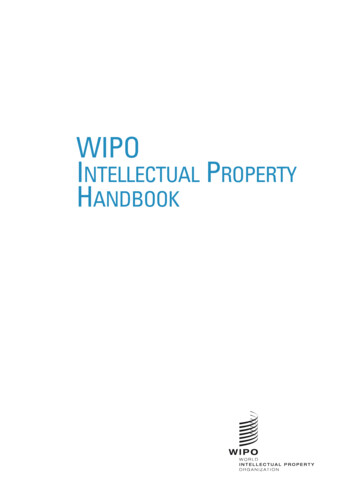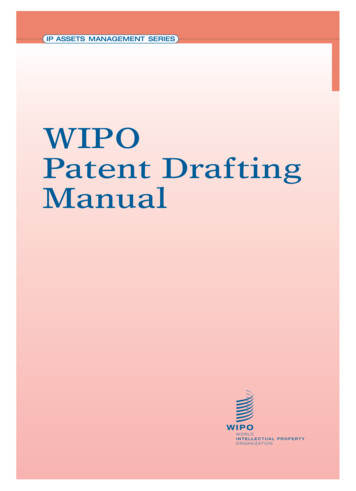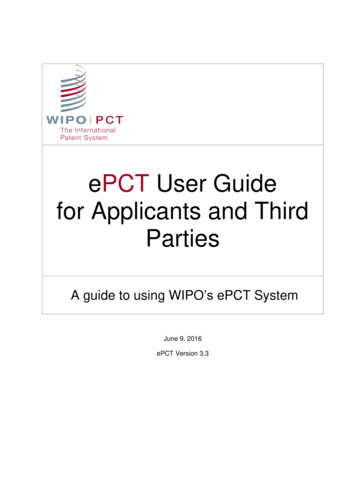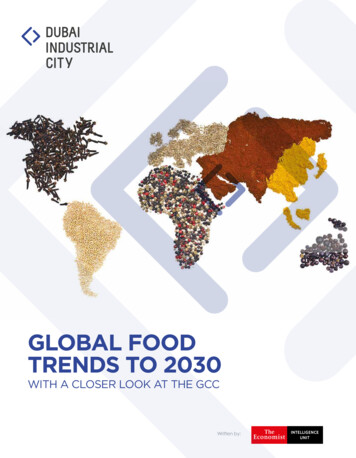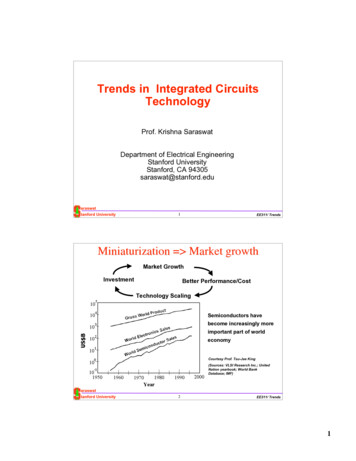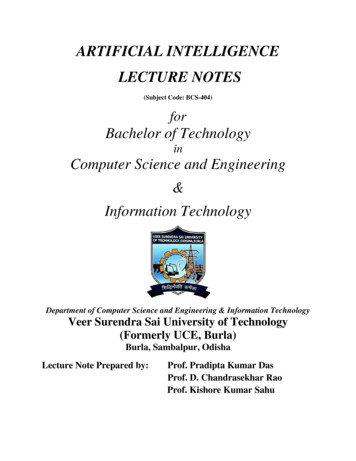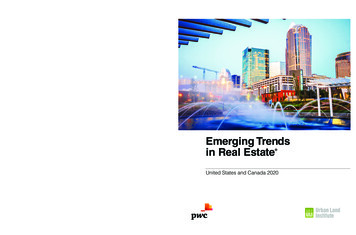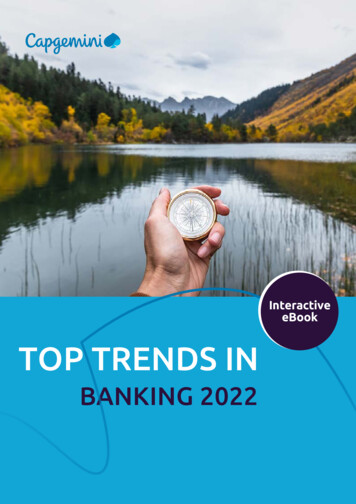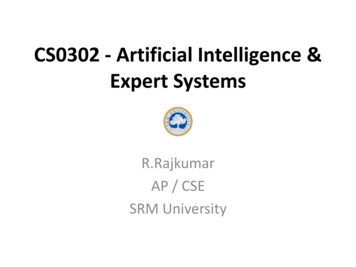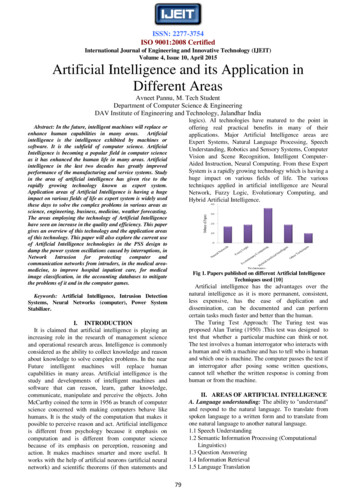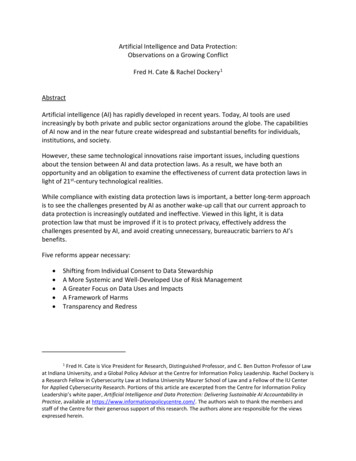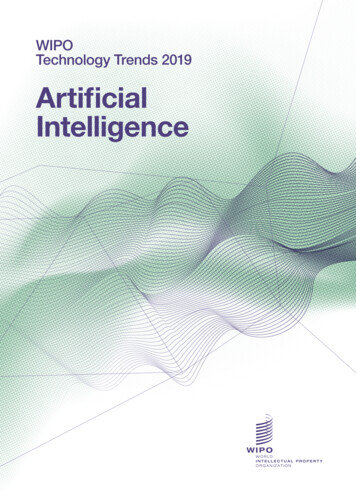
Transcription
WIPOTechnology Trends 2019ArtificialIntelligence
WIPOTechnology Trends 2019ArtificialIntelligence
The user is allowed to reproduce, distribute, adapt, translateand publicly perform this publication, including for commercial purposes, without explicit permission, provided that thecontent is accompanied by an acknowledgement that WIPOis the source and that it is clearly indicated if changes weremade to the original content.Suggested citation: WIPO (2019). WIPO Technology Trends2019: Artificial Intelligence. Geneva: World Intellectual tives should not carry anyofficial emblem or logo, unless they have been approved andvalidated by WIPO. Please contact us via the WIPO websiteto obtain permission.For any derivative work, please include the followingdisclaimer: “The Secretariat of WIPO assumes no liability orresponsibility with regard to the transformation or translationof the original content.”When content published by WIPO, such as images, graphics,trademarks or logos, is attributed to a third-party, the userof such content is solely responsible for clearing the rightswith the right holder(s).To view a copy of this license, please visit e designations employed and the presentation of materialthroughout this publication do not imply the expression of anyopinion whatsoever on the part of WIPO concerning the legalstatus of any country, territory or area or of its authorities,or concerning the delimitation of its frontiers or boundaries.This publication is not intended to reflect the views of theMember States or the WIPO Secretariat. WIPO, 2019First published 2019The mention of specific companies or products of manufacturers does not imply that they are endorsed or recommended by WIPO in preference to others of a similar naturethat are not mentioned.Photo credit: cover montage created with images by Margarita Lyr / iStock / Getty Images Plus and Daria Dombrovskaya / iStock / Getty Images PlusPrinted in SwitzerlandWorld Intellectual Property Organization34, chemin des Colombettes, P.O. Box 18CH-1211 Geneva 20, SwitzerlandISBN: 978-92-805-3007-0Attribution 3.0 IGO(CC BY 3.0 IGO)
Artificial intelligenceis a new digitalfrontier that willhave a profoundimpact on the world,transforming the waywe live and work.WIPO Director General, Francis Gurry
Preface71IntroductionForewordThe past, present and futureof AI: what research andinnovation trends can reveal;the data used in this reportand how it is analyzed; anda scheme for categorizingAI technologies.818 2 TrendsAbout thecontributors in artificialintelligence10Evolutionof AI patentapplicationsandscientificpublications3The historical developmentof AI innovation: analysisof trends in patents andscientific literature sincethe emergence of AI, andbreakdown by techniques,functional applications andapplication fields.38 Acknowledgments12Overall trends emergingfrom the data and analysis ofchanges over time, by regionand industry and the mostprominent entities.30Keyplayers inAI patenting4 ExecutivesummaryThe top applicants for AIpatents: how companies anduniversities/public researchorganizations compare, whichentities are most active ineach area and where theyare filing.1358
Geography 7 Key issues Selected AIof patentarising from categoriesfilingsAI and policy and termsresponses146Comprehensive analysis of5120Markettrends8 The futurerelated to AI of AI and theAnalysis of the use of AIIP systemtechnologies: data on6acquisitions, funding, opensource and patent litigationand oppositions.104Furtherreading150 The opportunities presentedby AI for business, societyand culture, and how AI and IPrights interact with each otherin the promotion of innovation.138WIPO Technology Trends 201982 Views from AI expertson the key policy andregulatory issues raised by AIapplications, plus examples ofpolicies proposed or enactedin various jurisdictions.5geographical trends, based onthe offices where patents arefiled, including both first andsubsequent filings.
This new report aimsto shed light on thetrends in innovation inAI since the field firstdeveloped in the 1950s.WIPO Director General, Francis Gurry
PrefaceBased on a detailed study of patents and otherinformation, this new report aims to shed lighton the trends in innovation in AI since the fieldfirst developed in the 1950s. Research hasinvolved the analysis of patent data relatedto AI inventions, as well as data on scientificpublications, litigation filings and acquisitionactivity. These data findings are discussed indetail and accompanied by commentary andindustry perspectives from more than 20 of theworld’s leading experts in AI; more completedatasets, patent search methodology andexpert contributions are openly available onthe WIPO website. We hope that this report willprove an invaluable resource for businesses,researchers and policymakers in the field, aswell as for those general readers who want tofind out how AI research has so far developed –and where it is going.The analysis offers unique insights into trendsin AI techniques (i.e., the different approachesused in AI, such as machine learning andfuzzy logic), AI functional applications (suchas natural language processing, speechprocessing and computer vision) and AIapplication fields (i.e., those industries andother sectors in which AI innovation is beingThis report identifies the key players inAI from both the corporate and publicsectors across different research areas andindustries. Furthermore, the analysis of thedata and the inputs from AI experts addressmany of the policy issues raised by AI, suchas the regulation and control of data, theincentivization of further research, the role ofintellectual property (IP) protection and thedevelopment of human-centered and ethical AIto benefit all.Together, the analysis of technological trendspresented in this report and the voices of AIexperts collected here are a valuable newaddition to a growing knowledge base on AI.I hope that this contribution will help to shiftdebate away from speculative interpretationand toward evidence-based projections,thereby informing global policymaking onthe future of AI, its governance and the IPframework that supports it.Francis GURRYDirector GeneralWIPO Technology Trends 2019AI is fast becoming part of our everyday lives,changing how we work, shop, travel andinteract with each other. Yet we are only atthe beginning of discovering the many waysin which AI will have an impact on – andindeed challenge – business, society andculture. There are numerous misconceptionsand misgivings about the nature of AI, and inparticular the challenge it poses to humankind.Given these widely held reservations andconcerns, it is essential to have a factual basisfor policy discussions about innovation in AI.Through this report, we hope to contributeevidence and bring clarity to this importantarea of debate.put into practice). One of the most strikingfindings of the report is that 50 percent of all AIpatents have been published in just the last fiveyears – a remarkable illustration of how rapidlyinnovation is advancing in this field.7I am pleased to present the first report in a newflagship series, WIPO Technology Trends. Thisfirst edition features artificial intelligence (AI) asthe theme. It is a fitting topic for the launch ofthe series as AI is a cutting-edge technologywith impacts on a wide range of businessesand activities.
ForewordAndrew NgCEO, Landing AIand deeplearning.aineural network, the better the neural networkperformed. We started looking for the biggestcomputers we could find. That discovery, andthe idea of using distributed computing toscale up neural networks, led to the creation ofGoogle Brain in 2011. Since then, deep learninghas made great progress as we’ve collectedmore data and created the powerful computersto make it work.I remember watching the final chess matchbetween Deep Blue and Gary Kasparov whileI was a graduate student at MIT in the 1990s.When Kasparov resigned, I jumped out ofmy chair in excitement – the AI communityhad finally triumphed over the humanchess champion!As AI continues to develop and transformindustry after industry, I hope it will createmany more similarly joyful experiences. Wehave a duty to address serious issues relatingto unemployment and inequality, but we shouldalso never lose sight of the value and possibilitythat AI brings.Even without this “holy grail,” AI is alreadycreating massive economic value in the worldtoday. In covering AI, the media tends to focuson images, speech and natural languageprocessing because those types of dataare very human. Everyone can understandwhat it means for a computer to identify acat or recognize your speech. But a lot of theeconomic value today is driven through deeplearning on “structured data.” Think of this asmachine learning applied to massive Excelspreadsheets (only bigger than the biggestExcel spreadsheet in the world). This data – forexample, what trucks should be dispatchedwhen, what products to recommend to whatuser – is more specific to individual companiesand industries. Structured data gets lessattention because it’s not as visual or intuitive.But it is driving massive value today and willcontinue as incumbent companies across allindustries transform themselves with AI.This report illustrates some of thosepossibilities and where they are arising. One ofits findings is that deep learning is the biggestand fastest growing technique in AI. When Iwas at Stanford in the 2000s, my PhD student,Adam Coates, came into my office with achart showing that the more data you fed to aWith this potential to transform every industryand create so much economic value, AIpresents just as great a technological shift asthe Internet did. In the Internet era, companiesincluding Microsoft and Apple saw the Internettrend early, and their leaders made strategicdecisions to become true Internet companies.ForewordThis moment stands out for me, amongmany milestones in the development of AI,such as the rise of deep learning, lessons inscalability and the DARPA Grand Challenge.AI is automation on steroids, and we had“automated” the process of playing chess. Iwas once captain of my high school chessteam and used to play competitively, but atthat moment I was happy to retire and leave itto the computers. This was not a sad event forme; on the contrary, I was thrilled to give upchess this way.8But we still have a long way to go in the field.For example, a toddler can usually recognizea cat after just one encounter, but a computerstill needs more than one example to learn.We need to find ways to train computers ontraining datasets as small as 100, or even10. Manufacturing lines, for example, usecomputer vision to check for defects in partsbut hopefully they will never have a millionexamples of defects to train on. Effective“unsupervised learning” – learning withoutlabelled data – remains a holy grail of AI.
Every organization can leverage its data anddomain expertise to build pilot AI projects.They will then be able to build internal AIteams that push their industries forward andcreate unique AI solutions. I recently releasedthe AI Transformation Playbook to helporganizations in all industries navigate theirown AI transformations.In order to help more people and businessesharness the potential of AI, we should considerthe following three actions:1. Build more public–private partnerships:When companies and universities orgovernment organizations work together,both sides can benefit. For example,university researchers can access moredata and understand relevant problems,and corporations can understand the latestbreakthroughs in technology.2. Continue promoting the free and opensharing of AI knowledge and resources:Companies have joined universities asleading forces for publishing free andopen AI research. The arXiv repositoryhas made a huge difference to the AIrevolution, as has the hosting service GitHubbecause it dramatically accelerates thefree dissemination of ideas. Other fieldscan learn this lesson and move away frompaywalled journals.3. Promote increased understanding of AI:Today, you can get a PhD to learn AI, but it’snot the only option. Traditional degrees, jobsthat allow you to learn, and at-home onlineToday, a significant amount of AI researchand education is taking place in the UnitedStates and China. These countries are hometo many of the best universities in the world,and their governments have provided fundingand created thoughtful regulations that enableinnovation. But the United States and Chinahave also built incredible business ecosystems.It’s very difficult for other countries, even thosewith great education, to compete with thebusiness, engineering and investing talent ofthose two countries.To close this gap, and work towardsdecentralizing the concentration of AItechnology, we must invest in education.Governments should invest heavily in educatingtheir citizens and enter public–private partnerships to adopt AI-powered systems safely.AI will transform every facet of society. Itbrings tremendous promise to improve ourlives and the world we live in, but it will requirethe creation of an AI ecosystem to ensurelong-term, sustainable growth. As this reporthighlights, AI technology and innovation hasuntil now been focused on a small numberof regions and organizations. In building afairer and more equitable AI-driven society,we must empower businesses, governmentsand citizens who may be impacted byautomation to ensure that the benefits of AI arewidely shared.WIPO Technology Trends 2019We are seeing a small number of incumbentcompanies undergo a similar transformationin the AI era. Google and Baidu were leadersin hiring AI talent and building pilot AI projects;they are now fully AI-driven companies. But AItransformation is not limited solely to Internetsearch companies. The biggest untappedopportunities today lie outside of the softwareindustry in industries such as agriculture,healthcare and manufacturing.learning programs (such as MOOCs) areall good ways for people to learn and workon important problems. The more widelyaccessible information we have, the moreflexibility people will have to learn.9This meant investing in the right technology,building teams, developing a digital strategyand adapting how they communicated abouttheir products.
About the contributorsThis report includes contributions fromexperts in AI, data, intellectual property,policy, and innovation. Their viewpoints andcomments complement and add contextto the information revealed in patent data,addressing issues such as existing andpotential uses and impact of AI technology,legal and regulatory questions, dataprotection and ethical concerns.Seth G Benzell is postdoctoralassociate at the MassachusettsInstitute of Technology (MIT)Initiative on the Digital EconomyNick Bostrom is Director of theFuture of Humanity Institute andauthor of Superintelligence: Paths,Dangers, StrategiesErik Brynjolfsson is Director at theMIT Initiative on the Digital EconomyYoon Chae is a senior associateBaker McKenzieFrank Chen is a partner atAndreessen HorowitzMyriam Côté is Director of AI forHumanity at Montreal Institute forLearning Algorithms (Mila)Boi Faltings is Professor of AIand Director of the AI Lab atÉcole polytechnique fédérale deLausanne (EPFL)Kay Firth-Butterfield is Head of AIand Machine Learning at the WorldEconomic Forum (WEF)10About the contributorsJohn G. Flaim is a partner andglobal head of the IP group atBaker McKenzieDario Floreano is Director of theLaboratory of Intelligent Systemsat EPFL and founding directorof the Swiss National Center ofCompetence in Robotics
Jay Iorio is a futuristRosalind Picard is founderand Director of the AffectiveComputing Research Group atthe Massachusetts Institute ofTechnology (MIT) Media LaboratoryMalcolm Johnson is DeputySecretary General of theInternational TelecommunicationsUnion (ITU)Hefa Song is Professor ofthe Institute of Science andManagement, Deputy Director ofthe Center for IPR Research andTraining, and Deputy Dean of theIntellectual Property School at theChinese Academy of Sciences (CAS)Konstantinos Karachaliosis Managing Director ofIEEE Standards Associationand a member of IEEE’sManagement CouncilPetr Šrámek is the founder of AIStartup Incubator and co-founderof the Platform on AI at theConfederation of Industry of theCzech RepublicKai-Fu Lee is founder of SinovationVentures and author of AISuperpowers: China, Silicon Valley,and the New World OrderAristotelis Tsirigos is Directorof the Applied BioinformaticsLaboratories at NYU School ofMedicineBen Lorica is Chief Data Scientistat O’Reilly MediaMiguel Luengo-Oroz is Chief DataScientist at UN Global PulseKazuyuki Motohashi is Professorin the Department of TechnologyManagement for Innovation at theUniversity of TokyoPaul Nemitz is Principal Adviser tothe European CommissionHaifeng Wang is Senior VicePresident at BaiduHerbert Zech is Professor of LifeSciences Law and IntellectualProperty Law at the Universityof BaselWIPO Technology Trends 2019Martin Ford is a futurist and authorof Rise of the Robots: Technologyand the Threat of a Jobless FutureEleonore Pauwels isResearch Fellow on EmergingCybertechnologies at theUN University’s Center forPolicy Research11Dominique Foray is Professor ofEconomics at EPFL
AcknowledgmentsThe report was prepared under the directionof Francis Gurry (Director General) and YoTakagi (Assistant Director General, GlobalInfrastructure Sector), supervised by AlejandroRoca Campaña (Senior Director, Accessto Information and Knowledge Division),under the responsibility of Irene Kitsara (IPInformation Officer, Access to Information andKnowledge Division).The report draws on commissionedbackground research, based on searchstrategy and methodology developed by thecore analytics team led by Irene Kitsara (WIPO),consisting of Sophie Gojon, Adrien Migeon andPhilippe Petit (CNRS Innovation) and PatriceLopez (science-miner). The AI dimensions usedfor the report and the related glossary weredeveloped by Patrice Lopez, who also providedexpert advice on AI in patent literature, withinputs by the core team, the WIPO AdvancedTechnologies Application Center (ATAC) andteam members of Mila (Simon Blackburn,Pierre Luc Carrier, Mathieu Germain, MargauxLuck, Gaétan Marceau Caron and JoaoFelipe Santos).Interviews were conducted and AI expertcontributions were compiled by James Nurton,who was the editor of the report, under theresponsibility of Charlotte Beauchamp (Head,Editorial and Design Section). Case studieswere kindly provided by contributors, AngelaHarp (IBM Research), Mohamad Ali Mahfouz(Microsoft Switzerland) and Sven Zirnite(Siemens Healthcare).12AcknowledgmentsThe report team benefited greatly fromexternal reviews of the draft chapters byBoi Faltings (EPFL), Patrice Lopez (scienceminer) and Alexandros Tsirigos (NYU MedicalSchool), and by WIPO colleagues Carsten Fink(Chief Economist), Akshat Dewan and BrunoPouliquen (from ATAC), and Marco Aleman,Allison Mages and Tomoko Miyamoto (fromWIPO’s Patent Law Division).The core team was skillfully assisted bycolleagues from WIPO’s Access to Informationand Knowledge Division, under the directionof Andrew Czajkowski. Thanks are due inparticular to Alica Daly, who validated the data,prepared the visualizations and contributedtogether with Alex Riechel to reviewing andfinalizing the report. Vipin Saroha preparedthe maps. Julie Summers provided valuableadministrative support. Additional dataand comments for the comparison of thereport findings with overall patent statisticswere provided by Kyle Bergquist, MosahidKhan, Julio Raffo and Hao Zhou, all from theEconomics and Statistics Division.Gratitude is due to the 27 leading experts in AIand contributors to the report who shared theirviews, provided their comments on differentaspects which enriched and contextualized thereport findings – their time and contribution aremuch appreciated. Thanks also to Andrew Ngfor providing the Foreword of the report, and toBridget Hickey for her facilitation.The report also draws on helpful inputreceived in the conceptualization phasefrom Phillippa Biggs (Senior Policy Analystat ITU), Virginia Dignum (Assistant Professorat the Faculty of Technology, Policy andManagement, Delft University of Technology),Kay Firth-Butterfield (Head, AI and MachineLearning at WEF), Jay Iorio (futurist),Konstantinos Karachalios (Managing Directorat IEEE Standards Association), and thelaw committee members of the IEEE GlobalInitiative on Ethics of Autonomous andIntelligent Systems, as well as from WIPOcolleagues Carsten Fink, Allison Mages,Christophe Mazenc, Bruno Pouliquen, NingXu; and on experience drawn from previousWIPO publications from the Economics andStatistics Division, shared by Mosahid Khan,Julio Raffo and Sacha Vincent-Wunsch.Gratitude is also due to the WIPOCommunications Division, in particularCharlotte Beauchamp for all the valuablecontributions and support throughout thepreparation of the publication, Edwin Hassinkand Sheyda Navab for the design of the reportand Ed Harris for helpful inputs; and to staffin the Printing Plant for their high-qualityservices. Gratitude is expressed to everyonewho worked hard and constructively towardscreating a new publication type and meetingchallenging deadlines.
Executive summaryArtificial intelligence (AI) is increasinglydriving important developmentsin technology and business, fromautonomous vehicles to medical diagnosisto advanced manufacturing. As AI movesfrom the theoretical realm to the globalmarketplace, its growth is fueled by aprofusion of digitized data and rapidlyadvancing computational processingpower, with potentially revolutionaryeffect: detecting patterns among billionsof seemingly unrelated data points, AIcan improve weather forecasting, boostcrop yields, enhance detection ofcancer, predict an epidemic and improveindustrial productivity.Technology trends can be discernedthrough patent analyticsDrawing on WIPO’s expertise in patent dataanalytics, this first publication in the seriesWIPO Technology Trends investigates thetrends in the emerging AI era: it analyzespatent, scientific publishing and other datato review past and current trends in AI, whileoffering insights into how innovation in this fieldis likely to develop in the coming years.This publication is among the first tosystematically research trends in AI technologyin order to discover which fields show thelargest amount of innovative AI activity, whichcompanies and what institutions are leadingAI development, and the location of futuregrowth markets.WIPO has devised a new framework for theunderstanding of developments in the field, withAI-related technologies grouped to reflect threedimensions of AI: techniques used in AI, suchas machine learning; functional applications,such as speech processing and computervision; and application fields, includingtelecommunications and transportation.Since artificial intelligence emerged in the1950s, innovators and researchers have filedapplications for nearly 340,000 AI-relatedinventions and published over 1.6 millionscientific publications.Notably, AI-related patenting is growing rapidly:over half of the identified inventions have beenpublished since 2013.WIPO Technology Trends 2019Andrew Ng, Landing AI and deeplearning.aiAI-related inventions are booming, shiftingfrom theory to commercial application13AI is the newelectricity. I canhardly imagine anindustry which isnot going to betransformed by AI.For each of these areas, this report providesdata and analysis that identify trends, keyplayers, geographical spread and marketactivity, including acquisitions and litigation.In addition, it includes contributions from AIexperts from across the globe, addressingissues such as existing and potential uses andimpact of AI technology, legal and regulatoryquestions, data protection and ethical concerns.
While scientific publications on AI date backdecades, the boom in scientific publicationson AI only started around 2001, approximately12 years in advance of an upsurge in patentapplications. Moreover, the ratio of scientificpapers to inventions has decreased from8:1 in 2010 to 3:1 in 2016 – indicative of ashift from theoretical research to the useof AI technologies in commercial productsand services.Some areas of AI are growing morequickly than others Machine learning is the dominant AI techniquedisclosed in patents and is included in morethan one-third of all identified inventions(134,777 patent documents). Filings of machinelearning-related patent have grown annuallyon annual average by 28 percent, with 20,195patent applications filed in 2016 (comparedwith 9,567 in 2013).The machine learning techniques revolutionizingAI are deep learning and neural networks, andthese are the fastest growing AI techniques interms of patent filings: deep learning showedan impressive average annual growth rate of175 percent from 2013 to 2016, reaching 2,399patent filings in 2016; and neural networks grewat a rate of 46 percent over the same period,with 6,506 patent filings in 2016.Among AI functional applications, computervision, which includes image recognition, is themost popular. Computer vision is mentionedin 49 percent of all AI-related patents (167,038patent documents), growing annually byan average of 24 percent (21,011 patentapplications filed in 2016).14Executive summaryThose AI functional applications with thehighest growth rates in patent filings in theperiod 2013 to 2016 were AI for robotics andcontrol methods, which both grew on averageby 55 percent a year.The growth rates observed in the identifiedAI-related patent data are noticeably higherthan the average annual growth rate for patentsacross all areas of technology, which was 10percent between 2013 and 2016. and many AI patents includeinventions that can be applied indifferent industries AI-related patents not only disclose AItechniques and applications, they often alsorefer to an application field or industry. Analysisshows that many sectors and industries areexploring the commercial exploitation of AI.Twenty application fields were identified inthe present analysis and at least one wasmentioned in 62 percent of the total identifiedAI patent data. These include, in order ofmagnitude: telecommunications (mentioned in15 percent of all identified patent documents),transportation (15 percent), life and medicalsciences (12 percent), and personal devices,computing and human–computer interaction(HCI) (11 percent). Other sectors featuring inthe results include banking; entertainment;security; industry and manufacturing;agriculture; and networks (including socialnetworks, smart cities and the Internetof things).Many AI-related technologies can find useacross different industries, as shown bythe large number of patents in AI that referto multiple industries. Transportation isprominent not only in the overall results, italso features among those fields showingthe highest growth rates in AI-related patentapplications, with a 33 percent annual growthbetween 2013 and 2016 (8,764 filings in 2016).Rapidly emerging within the transportationcategory are aerospace/avionics (67 percentannual growth, with 1,813 filings in 2016) andautonomous vehicles (42 percent annualgrowth, with 5,569 filings in 2016). The boomin transportation technologies becomesmore evident when we look at trends overthe period 2006–2016: representing just 20percent of applications in 2006, by 2016 itaccounted for one-third of applications (morethan 8,700 filings).While not showing the same high rate ofgrowth as transportation, patent filings inAI-related telecommunications still grewannually by an average of 23 percent between2013 and 2016, with 6,684 filings in 2016.Within telecommunications, the most growth
while certain AI techniques,applications and industries appear tobe closely linked.Nearly 70 percent of inventions related toAI mention an AI technique, application orfield in combination with another. The mostfrequent combinations in patent filings are:deep learning with computer vision; computervision with transportation, telecommunicationand security; ontology engineering withnatural language processing; and machinelearning with life and medical sciences. Thesecombinations suggest areas to watch for rapiddevelopments in AI in the near future.Companies, in particular those from Japan,the United States of America (U.S.) andChina, dominate patenting activityCompanies represent 26 out of the top 30AI patent applicants, while only four areuniversities or public research organizations.This pattern applies across most AItechniques, applications and fields. Of thetop 20 companies filing AI-related patents, 12are based in Japan, three are from the U.S.and two are from China. Japanese consumerelectronics companies are particularlyheavily represented.IBM and Microsoft are leaders in AIpatenting across different AI-related areasIBM has the largest portfolio of AI patentapplications with 8,290 inventions, followedby Microsoft with 5,930. Both companies’portfolios span a range of AI techniques,applications and fields, indicating that thesecompanies are not limiting their activity toa specific industry or field. Rounding outthe top five applicants are Toshiba (5,223),Samsung (5,102) and NEC (4,406). The StateGrid Corporation of China has leaped intothe top 20, increasing its patent filings by anaverage of 70 percent annually from 2013to 2016, particularly in the machine learningtechniques of bio-inspired approaches,which draw from observations of nature,and support vector machines, a form ofsupervised learning.In certain techniques and fields, the highestnumbers of patent applications originate fromcompanies with a high degree of specializationand expertise in that field. Examples includeBaidu, which ranks highly for deep learning,Toyota and Bosch, which are prominent intransp
impact on the world, transforming the way we live and work. WIPO Director General, Francis Gurry. Preface 7 Foreword 8 About the contributors 10 Acknowl- edgments 12 Executive summar
